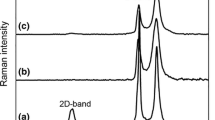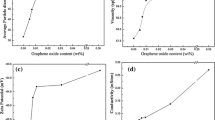Abstract
The final performance of polysulfide nanocomposites is highly affected by the microstructure of these materials. Moreover, interactions between the components involved in the structure of nanocomposites dictate the microstructure. Here, we investigate the nature and mechanism of interfacial interactions between graphene oxide (GO) nanosheets and poly(ethylene trisulfide) macromolecules (PETRS), with and without sodium dodecylbenzenesulfonate (SDBS) as a surfactant. Fourier transform infrared spectroscopy results show that GO nanosheets interact with SDBS molecules through non-covalent C–H···O hydrogen bonding between –OH groups of GO nanosheets and –CH3 groups of the SDBS. In addition, interfacial interactions between SDBS-modified GO nanosheets and PETRS macromolecules take place through two main mechanisms: (1) interactions between sulfur-containing segments of PETRS and C=O groups of GO nanosheets and (2) interactions between ethylene segments of polysulfide and C=O groups of GO. X-ray diffraction and transmission electron microscopy results confirm that the presence of SDBS on the interfacial region of GO nanosheets increases the exfoliation extent of GO nanosheets in the PETRS matrix. Also, differential scanning calorimetry and thermogravimetric analyses show that interactions between SDBS-modified GO and PETRS result in extended melting process and degradation range of nanocomposites. Moreover, the melting enthalpy of PETRS macromolecules increases noticeably in the presence of SDBS-modified GO nanosheets. This is in close accordance with the structural behavior of nanocomposites, where the semicrystalline behavior of PETRS macromolecules becomes more dominant in the presence of SDBS-modified GO nanosheets.











Similar content being viewed by others
References
Papageorgiou DG, Kinloch IA, Young RJ. Graphene/elastomer nanocomposites. Carbon. 2015;95:460–84.
Li B, Zhong W-H. Review on polymer/graphite nanoplatelet nanocomposites. J Mater Sci. 2011;46(17):5595–614.
Paszkiewicz S, Szymczyk A, Špitalský Z, Soccio M, Mosnáček J, Ezquerra TA, et al. Electrical conductivity of poly(ethylene terephthalate)/expanded graphite nanocomposites prepared by in situ polymerization. J Polym Sci Part B Polym Phys. 2012;50(23):1645–52.
Sengupta R, Bhattacharya M, Bandyopadhyay S, Bhowmick AK. A review on the mechanical and electrical properties of graphite and modified graphite reinforced polymer composites. Prog Polym Sci. 2011;36(5):638–70.
Kuilla T, Bhadra S, Yao D, Kim NH, Bose S, Lee JH. Recent advances in graphene based polymer composites. Prog Polym Sci. 2010;35(11):1350–75.
Allahbakhsh A, Sharif F, Mazinani S. The influence of oxygen-containing functional groups on the surface behavior and roughness characteristics of graphene oxide. Nano. 2013;08(04):1350045.
Allahbakhsh A, Mazinani S. Influences of sodium dodecyl sulfate on vulcanization kinetics and mechanical performance of EPDM/graphene oxide nanocomposites. RSC Adv. 2015;5(58):46694–704.
Li X, Wang H, Robinson JT, Sanchez H, Diankov G, Dai H. Simultaneous nitrogen doping and reduction of graphene oxide. J Am Chem Soc. 2009;131(43):15939–44.
Li MJ, Liu CM, Xie YB, Cao HB, Zhao H, Zhang Y. The evolution of surface charge on graphene oxide during the reduction and its application in electroanalysis. Carbon. 2014;66:302–11.
Bian J, Lin HL, He FX, Wang L, Wei XW, Chang IT, et al. Processing and assessment of high-performance poly(butylene terephthalate) nanocomposites reinforced with microwave exfoliated graphite oxide nanosheets. Eur Polym J. 2013;49(6):1406–23.
Wang WP, Liu Y, Li XX, You YZ. Synthesis and characteristics of poly(methyl methacrylate)/expanded graphite nanocomposites. J Appl Polym Sci. 2006;100(2):1427–31.
Shanks RA, Cerezo FT. Preparation and properties of poly(propylene-g-maleic anhydride) filled with expanded graphite oxide. Compos A. 2012;43(7):1092–100.
Piana F, Pionteck J. Effect of the melt processing conditions on the conductive paths formation in thermoplastic polyurethane/expanded graphite (TPU/EG) composites. Compos Sci Technol. 2013;80:39–46.
Wang Y-X, Huang L, Sun L-C, Xie S-Y, Xu G-L, Chen S-R, et al. Facile synthesis of a interleaved expanded graphite-embedded sulphur nanocomposite as cathode of Li–S batteries with excellent lithium storage performance. J Mater Chem. 2012;22(11):4744.
Allahbakhsh A, Sheydaei M, Mazinani S, Kalaee M. Enhanced thermal properties of poly(ethylene tetrasulfide) via expanded graphite incorporation by in situ polymerization method. High Perform Polym. 2013;25(5):576–83.
Haghighi AH, Sheydaei M, Allahbakhsh A, Ghatarband M, Hosseini FS. Thermal performance of poly(ethylene disulfide)/expanded graphite nanocomposites. J Therm Anal Calorim. 2014;117(2):525–35.
Sheydaei M, Allahbakhsh A, Haghighi AH, Ghadi A. Synthesis and characterization of poly(methylene disulfide) and poly(ethylene disulfide) polymers in the presence of a phase transfer catalyst. J Sulfur Chem. 2013;35(1):67–73.
Kim NH, Kuila T, Kim KM, Nahm SH, Lee JH. Material selection windows for hybrid carbons/poly(phenylene sulfide) composite for bipolar plates of fuel cell. Polym Test. 2012;31(4):537–45.
Feng S, Shang Y, Xie X, Wang Y, Xu J. Synthesis and characterization of crosslinked sulfonated poly(arylene ether sulfone) membranes for DMFC applications. J Membr Sci. 2009;335(1–2):13–20.
Li L, Yang X, Zhao J, Gao J, Hagfeldt A, Sun L. Efficient organic dye sensitized solar cells based on modified sulfide/polysulfide electrolyte. J Mater Chem. 2011;21(15):5573.
Wang J, Chew SY, Zhao ZW, Ashraf S, Wexler D, Chen J, et al. Sulfur–mesoporous carbon composites in conjunction with a novel ionic liquid electrolyte for lithium rechargeable batteries. Carbon. 2008;46(2):229–35.
Ji L, Rao M, Zheng H, Zhang L, Li Y, Duan W, et al. Graphene oxide as a sulfur immobilizer in high performance lithium/sulfur cells. J Am Chem Soc. 2011;133(46):18522–5.
Allahbakhsh A, Sharif F, Mazinani S, Kalaee MR. Synthesis and characterization of graphene oxide in suspension and powder forms by chemical exfoliation method. Int J Nano Dimens. 2014;5(1):11–20.
Sonker AK, Wagner HD, Bajpai R, Tenne R, Sui X. Effects of tungsten disulphide nanotubes and glutaric acid on the thermal and mechanical properties of polyvinyl alcohol. Compos Sci Technol. 2016;127:47–53.
Vyazovkin S. Evaluation of activation energy of thermally stimulated solid-state reactions under arbitrary variation of temperature. J Comput Chem. 1997;18(3):393–402.
Vyazovkin S, Burnham AK, Criado JM, Pérez-Maqueda LA, Popescu C, Sbirrazzuoli N. ICTAC Kinetics Committee recommendations for performing kinetic computations on thermal analysis data. Thermochim Acta. 2011;520(1–2):1–19.
Vyazovkin S, Dollimore D. Linear and nonlinear procedures in isoconversional computations of the activation energy of nonisothermal reactions in solids. J Chem Inf Comput Sci. 1996;36(1):42–5.
Allahbakhsh A, Mazinani S, Kalaee MR, Sharif F. Cure kinetics and chemorheology of EPDM/graphene oxide nanocomposites. Thermochim Acta. 2013;563:22–32.
Yan J, Zhao Z, Pan L. Growth and characterization of graphene by chemical reduction of graphene oxide in solution. Phys Status Solid A. 2011;208(10):2335–8.
Hu W, He G, Chen T, Guo CX, Lu Z, Selvaraj JN, et al. Graphene oxide-enabled tandem signal amplification for sensitive SPRi immunoassay in serum. Chem Commun. 2014;50(17):2133.
Elman AR, Davydov IE, Kononov LO, Zinin AI, Dugin SN. Synthesis of (13C-methoxy)methacetin for isotopic breath tests. Pharm Chem J. 2014;48(4):279–83.
Jiang Z, Zhao X, Fu Y, Manthiram A. Composite membranes based on sulfonated poly(ether ether ketone) and SDBS-adsorbed graphene oxide for direct methanol fuel cells. J Mater Chem. 2012;22(47):24862.
Huiqun C, Meifang Z, Yaogang L. Decoration of carbon nanotubes with iron oxide. J Solid State Chem. 2006;179(4):1208–13.
Qian W, Krimm S. Vibrational spectroscopy of hydrogen bonding: origin of the different behavior of the C–H···O hydrogen bond. J Phys Chem A. 2002;106(28):6628–36.
Scheiner S, Kar T. Effect of solvent upon CH···O hydrogen bonds with implications for protein folding. J Phys Chem B. 2005;109(8):3681–9.
Lee KM, Chang H-C, Jiang J-C, Chen JCC, Kao H-E, Lin SH, et al. C–H–O hydrogen bonds in β-sheetlike networks: combined X-ray crystallography and high-pressure infrared study. J Am Chem Soc. 2003;125(40):12358–64.
Fulmer GR, Miller AJM, Sherden NH, Gottlieb HE, Nudelman A, Stoltz BM, et al. NMR chemical shifts of trace impurities: common laboratory solvents, organics, and gases in deuterated solvents relevant to the organometallic chemist. Organometallics. 2010;29(9):2176–9.
Heimer NE, Field L, Neal RA. Biologically oriented organic sulfur chemistry. 21. Hydrodisulfide of a penicillamine derivative and related compounds. J Org Chem. 1981;46(7):1374–7.
Grassi G, Tyblewski M, Bauder A. Convenient preparation and spectroscopic characterization of methyl hydrodisulfide and methyl deuterodisulfide. Helv Chim Acta. 1985;68(7):1876–9.
Izunobi JU, Higginbotham CL. Polymer molecular weight analysis by1H NMR spectroscopy. J Chem Educ. 2011;88(8):1098–104.
Gulmine JV, Janissek PR, Heise HM, Akcelrud L. Polyethylene characterization by FTIR. Polym Test. 2002;21(5):557–63.
Wang Y. FTIR study of adsorption and reaction of SO2 and H2S on Na/SiO2. Appl Catal B. 1998;16(3):279–90.
Sundarrajan S, Srinivasan KSV. Thermal degradation processes in poly(acyl sulfides) investigated by pyrolysis-gas chromatography/mass spectrometry. Macromol Rapid Commun. 2003;24(12):724–31.
Author information
Authors and Affiliations
Corresponding author
Electronic supplementary material
Below is the link to the electronic supplementary material.
Rights and permissions
About this article
Cite this article
Allahbakhsh, A., Haghighi, A.H. & Sheydaei, M. Poly(ethylene trisulfide)/graphene oxide nanocomposites. J Therm Anal Calorim 128, 427–442 (2017). https://doi.org/10.1007/s10973-016-5915-7
Received:
Accepted:
Published:
Issue Date:
DOI: https://doi.org/10.1007/s10973-016-5915-7




